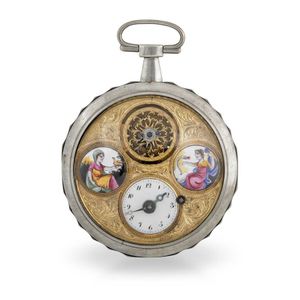Enamel and Diamond Watch with Mock Pendulum
You must be a subscriber, and be logged in to view price and dealer details.
Subscribe Now to view actual auction price for this item
When you subscribe, you have the option of setting the currency in which to display prices to $Au, $US, $NZ or Stg.
- Dial Plate - The dial plate is the front plate of a clock or watch, and may have the numerals painted or engraved on it, as well as cut-outs for the hands, date apertures, strike/silent adjustment or automata. On some clocks a chapter ring, displaying the numerals may sit on top of the dial plate.
- Date Aperture - A date aperture is a cut out section in the face of a watch or clock, displaying the day of the month.
- Pendulum - The pendulum was discovered around 1602 by Galileo Galilei, and was adopted for time keeping by the Dutch mathematician and natural philosopher, Christiaan Huygens, who excelled in astronomy, physics, and horology.
The pendulum comprises a metal rod usually of brass or steel with a metal disk, known as a bob, at the end. The movement of the pendulum is driven by weights or a spring, and as a pendulum swings in a regular arc, it was found accuracy could be controlled to within a few seconds a week.
Timekeeping can be adjusted by changing the height of the bob on the rod, making the pendulum either swing slower or faster.
The disadvantage of the pendulum was that changes in temperature also changed the length of the pendulum, interfering with the accuracy of the clock, and so in the 18th century two types of mercurial pendulums were invented which countered the movement in the steel rod.
The pendulum was the world's most accurate timekeeping technology until the invention of the quartz clock, regulated by a quartz crystal, in 1927. - Movement - The technical name for the workings of a clock or watch, and does not include the dial or case.
- Foliate - Decorated with leaves or leaf-like forms.
- Circa - A Latin term meaning 'about', often used in the antique trade to give an approximate date for the piece, usually considered to be five years on either side of the circa year. Thus, circa 1900 means the piece was made about 1900, probably between 1895 and 1905. The expression is sometimes abbreviated to c.1900.
This item has been included into following indexes:
- pocket watches, case type
- pocket watches, country - Swiss made 416
- pocket watches, features - ladies 427
Visually similar items

A silver and polychrome enamel open-faced verge watch case 2035 Continental circa 1830, gilt full plate movement, fusee escapement, the gilt foliate engraved dial plate inset with exposed pierced balance, above a white enamel dial with Arabic numerals and

A rare early 19th century gold Swiss/French automata Repeat/Strike pocket watch, cobalt blue chapter ring with relief silver and gold figures that strike the hours and quarter on demand. Verge movement pierced cockplate with end stone. Diameter 54 mm.

A French Louis XV style mantel clock with white marble case and plinth and gilt metal mounts, the circular case surmounted by an ormolu trophy pediment of a flaming torch and quiver of arrows; two cherubs support the case whilst kneeling upon a plateau pli

A 14ct gold lady's pocket watch, golden dial with Roman numerals, stem wind push piece at 1oclock in a finely engraved case. Working but stops.
